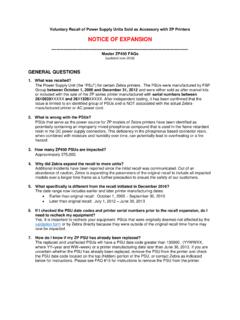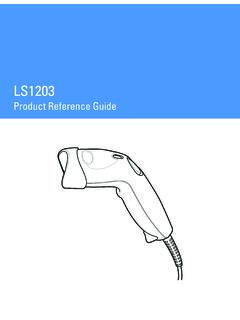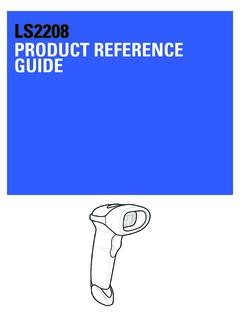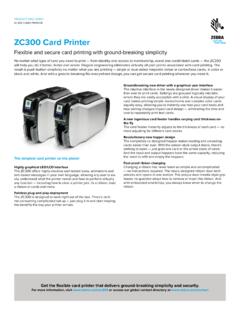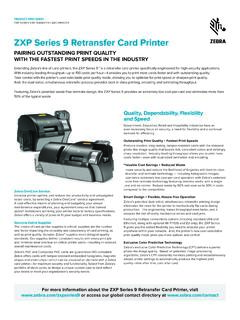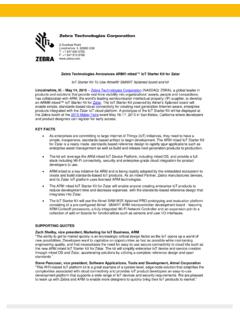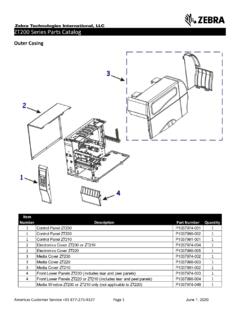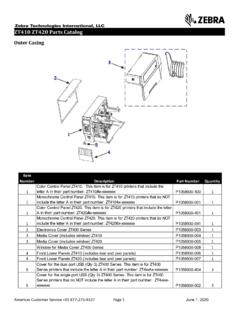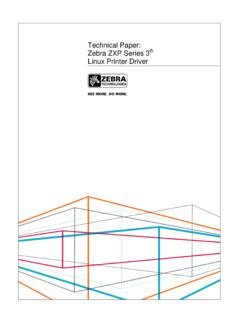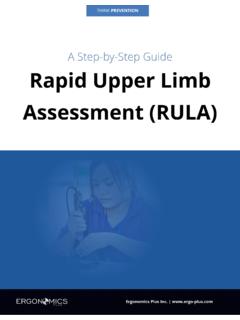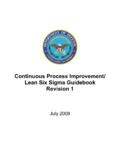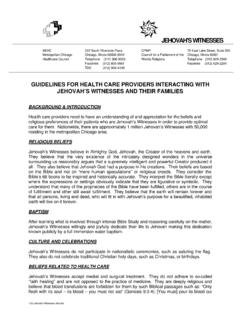Transcription of Eliminate 7 Wastes from Your Supply Chain - Zebra …
1 Eliminate 7 Wastes from your Supply ChainWITH REAL-TIME ASSET MANAGEMENT SOLUTIONS FROM Zebra LOCATION SOLUTIONSIn difficult economic times, lean thinking strikes a chord for manufacturers as it promises to reduce costs, improve quality and transform the bottom line, by eliminating waste in every area of the value stream, including factory management and supplier networks. Its goal is to Eliminate non-value added processing from the customers perspective, enabling less inventory, less space, less resource, less time and less cost to produce more and all highly responsive to customer white paper examines the impact of leveraging proven lean principles supported by Real-time Asset Management Solutions from Zebra Technologies. We will identify the seven Wastes of manufacturing and how Real-time Asset Management Solutions can eradicate these Wastes . You will also learn first hand how customers eliminated waste and benefited from these PAPERREAL-TIME ASSET MANAGEMENT SOLUTIONSTHE SEVEN Wastes IN MANUFACTURING1.
2 Over-productionProducing more than and / or ahead of demand. The result of producing to speculative (forecast) demand or supposed economic batches, it is visible as excessive, time consuming and costly material WaitingWhether for the previous, current or next step in the process, the result is wasted worker time. The goal is to maximize the utilization and / or efficiency of operatives first and machines TransportationUnnecessary transport of materials, WIP (work in progress) and finished goods adds zero value to the product. Instead of improving transportation processes and systems, lean thinking first favours minimizing or eliminating Non-value added processingDoing more work than is necessary, according to the value principle often due to poor plant layout or misguided attempts to recover expensive machinery costs. Lean essentially advocates using simpler, lower cost tools, cell manufacturing and / or combining steps, where Unnecessary motionRelating to people bending, stretching or walking too far, due primarily to the inappropriate location (and potentially also design) of tools, parts inventories and fixtures.
3 Instead of simply automating wasted motion, lean requires that the operations themselves be Excess inventorySpecifically referring to WIP between operations and purchased parts within the Supply Chain , frequently resulting from overproduction, usually due to excessively large batch manufacturing or processes with long cycle times leading in turn to cost and clutter. This waste also creates additional waste in the form of increased lead-times, excessive floor space requirements, extra handling, high interest charges, avoidable people movement and paperwork and, again, the associated DefectsProducing defective parts or products results in rework and scrap and invariably adds significantly to manufacturing costs. Lean focuses on preventing the occurrence of defects, rather than improving the processes around finding and repairing technologies 2 WHITE PAPERREAL-TIME ASSET MANAGEMENT SOLUTIONSLean Manufacturing is About the Obsessive Elimination of waste waste being defined by lean practitioners as what customers would perceive as processes and actions that don t add value , and for which they don t want to pay.
4 Given the current difficult conditions for much of manufacturing in the developed world, lean is also commonly associated with getting more from less. But for the tightest definition, go to the US National Institute of Standards and Technology (NIST) Manufacturing Extension Partnership (MEP), which describes lean as: A systematic approach to identifying and eliminating waste through continuous improvement, flowing the product at the pull of the customer in pursuit of perfection. First, deliver value with, as above, the customer at front of , identify the value stream (by value stream mapping all the stages of production, warehousing and ultimately the entire business).Third, make the value flow, with a goal (mostly unreachable) of single piece flow, by moving from the current state to a chosen future state and remembering, crucially, that information also needs to , make-to-order, meaning only make or do anything when you need to using, for example, JIT ( just in time) , strive for (almost unattainable) perfection, using the methodologies and tools for both continuous and blitz (kaizen) improvements.
5 Succinct, yes, but useful too because implicit in that sentence is a clear warning for lean manufacturing wannabes to avoid cherry picking lean initiatives and methodologies such as simply setting up kanban replenishment, focusing on reducing set-up times, or doing the workplace 5Ss (sort, set in order, shine, standardize and sustain) somewhere in production or a warehouse. Instead, this definition of lean manufacturing leads instantly to the strategic, top down view, as enshrined in lean s five governing all of that thinking is removal of the seven prevalent Wastes of lean manufacturing those aspects that, again, fail to add technologies 3 WHITE PAPERREAL-TIME ASSET MANAGEMENT SOLUTIONSA ddressing waste in the Real WorldLEAN THINKING IS PRAGMATIC Although lean methodology drives towards zero inventory, zero waiting, rapid changeovers, zero duplication and so on, its practitioners recognize that much of production and distribution necessarily involves some batch, and even forecast, processes.
6 They also understand that commercial pressures, often beyond a manufacturer s direct control, influence purchasing and stocking , whether those issues concern material availability and pricing, or customer service strategies dictated by competition, there is scope in lean thinking for some apparent waste , particularly in the areas of overproduction and transportation. However, while some waste might be justifiable, lean s principles consistently emphasize root cause analysis and a sharp focus on systemic improvement focusing on value, using its improvement methodologies, practices and KPIs, and implementing systems and processes that sustain importantly, lean thinking also implicitly recommends judicious use of IT systems, particularly where the intention is to use lean principles beyond the simple repetitive production environments for which it was originally intended as in the Toyota Production System.
7 Quite simply, lean practitioners recognize that in a volatile and / or complex Supply Chain , whether internal or external, modern manufacturers just cannot implement lean practices on visual queues and takt times alone. Thus, with appropriate solutions configured to collect data, disseminate information, enable visibility and automate background processes such as those around material replenishment and assembly finishing, including outside the four walls of the factory even complex manufacturing organizations benefit from lean is the case no matter how prone production and Supply chains are to the challenges of product mix, demand variability and / or the realities of breakdowns and resulting material availability problems. Timely information aimed at delivering visibility of materials, WIP, scrap etc, as well as automating material flow and assisting with the understanding, communication and resolution of downtime issues directly addresses the seven the rise of Lean Application Solutions in the form of e-kanbans, lean loop replenishment sizing applications, Web EDI and, most recently, Real-time Asset Management Solutions.
8 Looking at the latter, those developed by Zebra Technologies Corporation, offers world-class solutions to optimize the flow of goods and manage assets across the global Supply Technologies provides an integrated wireless infrastructure for real-time location, digital messaging, telemetry and wireless networking applications. Together these give manufacturers, spanning aerospace, automotive, industrial and government industries, the ability to continuously manage the physical location and status of their business critical assets, equipment and people. Whether tracking containers through a port, optimizing parts for manufacturing or managing ground support equipment at an airport, these automated solutions provide complete visibility and greater velocity to deliver measurable business improvement. In addition, the solutions support lean principles and reliably and cost effectively manage everything from material replenishment to defective materials and valuable mobile resources, delivering a return on investment within 3 to 12 on patented, standards-compliant technology resulting from a collective 100-plus years of development, Zebra Real-time Asset Management Solutions enable companies such as Whirlpool, BMW Subaru, Ford Motor Company, GETRAG FORD, Jaguar Land Rover and Hawker Beechcraft to reduce inventory, lower operating costs and improve operations through lean technologies 4 WHITE PAPERREAL-TIME ASSET MANAGEMENT SOLUTIONSZ ebra Location Solutions Real-Time Asset Management SolutionsMATERIAL FLOW SOLUTION Zebra Material Flow Solution is a comprehensive execution management solution that streamlines the entire replenishment process.
9 Material Flow Solution provides manufacturing operations with the ability to centrally manage and control supplier collaboration, internal Supply and facility-wide communication across multiple facilities or within a single location. Designed to support and automate lean replenishment techniques, Material Flow Solution eliminates disjointed, labor intensive processes, granting every member of the Supply Chain access to actionable, real-time data from the factory floor to internal and external Supply . It enables all stakeholders to respond quickly to changes in inventory and production status, as well as customer requests. In addition, it easily integrates with ERP solutions, such as SAP, Oracle and QAD, to enhance operational visibility, throughput and quality, while also reducing inventory and labor Flow Solution directly addresses almost all of the seven Wastes in the following ways.
10 Decreasing on-hand inventory by 5-10%, by cutting the waste of over-production and dramatically reducing excess inventory Reducing labor costs by 15-20%, by tackling the Wastes of waiting and unnecessary motion Improving asset utilization by 5-10%, by reducing moves towards over-processing and preventing the waste of waiting Eliminating line stoppages and business interruptions, again cutting into the waste of waiting Decreasing expedite fees, directly impacting the waste of transportation Reducing cycle times and increase throughput in line with lean s fundamental value and customer-pull principlesHow Does it Work? Material Flow Solution automates the inventory replenishment process and reduces inventory holding costs by enabling line-side operators to trigger material requests from their workstations, either by pressing the wireless WhereCall RFID button, scanning a barcode, or by integrating with a third party system.
